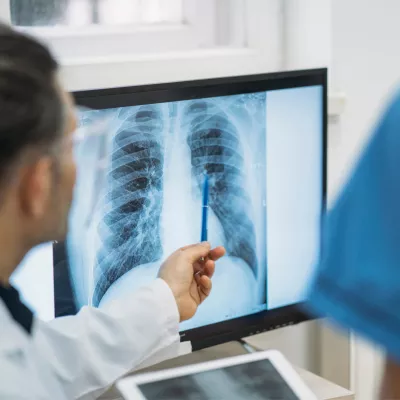- AdventHealth

Choose the health content that’s right for you, and get it delivered right in your inbox.
Hugh Jackman is urging others to practice sun safety after sharing his most recent skin cancer scare on social media.
Skin cancer is the abnormal growth of skin cells, and it’s a common form of cancer that can occur anywhere on the body. The actor recently underwent two biopsies after a recent doctor’s visit; however, this isn’t Jackman’s first skin cancer scare, as he had his first skin cancer removal in 2013 and has undergone several additional procedures since.
"Please wear sunscreen, it is just not worth it, no matter how much you want a tan. Trust me!" he said.
What is Skin Cancer?
Skin cancer is a type of cancer that develops in the skin cells. Skin cancer is the most common type of cancer globally according to the American Academy of Dermatology (AAD). Skin cancer primarily occurs on areas of sun-exposed skin — including your arms and hands, scalp, face, lips, ears, neck, chest and legs — though it may also form on less common areas of the body, including your palms, under your nail beds and your genital area, so it’s important to screen yourself for any noticeable changes to your skin regularly.
Types of Skin Cancer
Basal Cell Carcinoma (BCC):
- This is the most common type of skin cancer.
- It originates in the basal cells, which are found at the bottom of the epidermis (the outermost layer of skin).
- BCC typically appears as a painless, raised area of skin that may be shiny or pearly in appearance.
- It tends to grow slowly and rarely spreads to other parts of the body.
Squamous Cell Carcinoma (SCC):
- This type of skin cancer arises from the squamous cells, which are found in the middle and outer layers of the skin.
- SCC often appears as a red, scaly, or crusted bump on the skin.
- It can be more aggressive than BCC and has a higher likelihood of spreading to other parts of the body.
Melanoma:
- This is the most dangerous form of skin cancer.
- It develops in the melanocytes, the cells that produce pigment (melanin) that gives skin its color.
- Melanoma can develop from an existing mole or suddenly appear as a new dark spot on the skin.
- It has a higher tendency to spread (metastasize) to other parts of the body, making it more difficult to treat if not caught early.
Skin Cancer Symptoms
Basal cell carcinoma, squamous cell carcinoma and melanoma are the major types of skin cancer to be aware of. Signs of skin cancer can vary; potentially concerning skin cancer symptoms to be aware of include:
- Existing moles that change in color, size or feel, or that bleed
- Brown, red or purple spots or patches
- Lesions — these may appear red, pink, white, blue or blue-black and might be scaly, scar-like, or crusted
- New bumps or nodules — they may be firm, pearly, or waxy
While the cause of these symptoms is not always skin cancer, it is always best to keep your dermatologist or health care provider informed so they can help you obtain treatment, if necessary.
Skin Cancer Risk Factors
A risk factor is anything that increases the chance of developing cancer. Risk factors can be behaviors, substances, conditions, or genetic traits that are associated with a higher likelihood of cancer development. While having one or more risk factors does not mean that a person will definitely get cancer, it does increase the probability compared to individuals without these risk factors. Similarly, some people who develop cancer may not have any known risk factors.
Some skin cancer risk factors are:
- Excessive exposure to ultraviolet (UV) radiation from the sun or tanning beds.
- Fair skin, light hair, and light eye color.
- Family history of skin cancer.
- Certain genetic conditions, such as xeroderma pigmentosum.
- A large number of moles or atypical moles.
- A history of sunburns and sun damage, particularly early in life.
- Weakened immune system.
Skin Cancer Treatment
Skin cancer treatment options depend on the type, size, location, and stage of the cancer. Common treatments include:
- Surgical removal of the cancerous tissue.
- Cryotherapy (freezing the cancer cells).
- Topical medications.
- Radiation therapy.
- Chemotherapy.
- Immunotherapy and targeted therapy for advanced melanoma.
Early detection and treatment can play a huge part in a skin cancer journey. If you notice any changes in your skin, such as new growths, sores that do not heal, or changes in existing moles, it's important to consult your healthcare provider.
Skin Cancer Causes
Skin cancer is primarily caused by damage to the DNA in skin cells, which leads to abnormal cell growth. Various factors can contribute to this DNA damage, and the causes can be broadly categorized into environmental, genetic, and lifestyle factors. Here are the main causes of skin cancer:
1. Ultraviolet (UV) Radiation:
- Sun Exposure: The most common cause of skin cancer is prolonged exposure to ultraviolet (UV) radiation from the sun. UV exposure damages the DNA in skin cells, leading to mutations and the development of cancer.
- Tanning Beds: Artificial sources of UV radiation, such as tanning beds and sunlamps, can also increase the risk of skin cancer.
2. Genetic Factors:
- Family History: Having a family history of skin cancer can increase an individual's risk, suggesting a genetic predisposition.
- Genetic Mutations: Certain genetic conditions make individuals more susceptible to UV rays and increase the risk of skin cancer.
3. Fair Skin:
- Skin Type: Individuals with fair skin, light hair, and light eyes are at higher risk because they have less melanin, which provides some protection against UV radiation.
- Sunburn History: People who have had severe sunburns, especially in childhood, are at a higher risk of developing skin cancer later in life.
4. Weakened Immune System:
- Immunosuppression: People with weakened immune systems, such as organ transplant recipients taking immunosuppressive drugs or individuals with HIV/AIDS, have a higher risk of skin cancer.
5. Chemical Exposure:
- Carcinogens: Exposure to certain chemicals, such as arsenic, can increase the risk of skin cancer.
6. Age and Gender:
- Age: The risk of skin cancer increases with age, as the cumulative exposure to UV radiation and other risk factors adds up over time.
- Gender: Men are generally at a higher risk of developing skin cancer than women, partly due to higher levels of outdoor activity and occupational exposure.
7. Previous Skin Cancer:
- History of Skin Cancer: Individuals who have had skin cancer before are at higher risk of developing it again.
8. Radiation Therapy:
- Medical Treatments: People who have received radiation therapy for other conditions may have an increased risk of developing skin cancer in the treated area.
9. Certain Medical Conditions and Treatments:
- Chronic Inflammation or Injury: Chronic skin inflammation or injury, such as scars or burns, can increase the risk of skin cancer.
- Human Papillomavirus (HPV): Certain strains of HPV are associated with an increased risk of squamous cell carcinoma.
Understanding Sun Exposure, Skin Cancer Prevention, and Practicing Sun Safety
Though Jackman is native to Australia, which has the highest skin cancer rate in the world, he has said his prior diagnoses have still come as a surprise.
“It’s always a bit of a shock just hearing the word ‘cancer,’” he shared. “Being Australian it’s a very common thing. I never wore sunscreen growing up, so I was a prime candidate for it.”
While his recent biopsies have thankfully come back negative, Jackman hopes his skin cancer scare reminds people to be sun safe. Exposure to ultraviolet radiation plays a large part in the formation of skin cancer cells.
Here are some tips to promote sun safety and limit unnecessary sun exposure:
Limit Unnecessary Sun Exposure
- Avoid indoor tanning beds and tanning lotions with low SPF (sun protection factor)
- Limit your time in the sun to avoid over-exposure
Wear Sunscreen
- Use sunscreen products — UV protection even on cloudy days, your skin can be exposed to high levels of UV rays
- Sunscreen use and products including titanium dioxide and zinc oxide can help protect against the sun’s UV rays
- Consider a broad-spectrum sunscreen which protects against both ultraviolet A (UVA) and ultraviolet B (UVB) rays from the sun
- Consider a water-resistant sunscreen with a 30 SPF minimum
Wear Protective Clothing
- Wear a wide-brimmed hat —the scalp is a common area of occurrence for skin cancer formation; if you plan to be outside for a while, wearing a hat is a great way to keep your scalp protected
- Sun-protective clothing can be a great addition to outdoor adventures like beach days, hiking, fishing, or playing.
Schedule Your Screening
Skin care is often overlooked as part of health care, but it’s important to make it a priority. It’s a good idea to see a dermatologist annually. Early detection of skin cancer gives you the greatest likelihood of successful skin cancer treatment. And while not all skin changes are caused by skin cancer, if you notice any changes that cause you to worry, schedule an appointment with your doctor right away.


